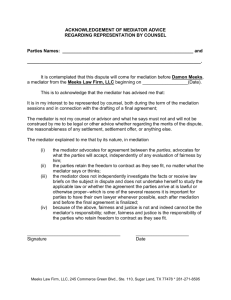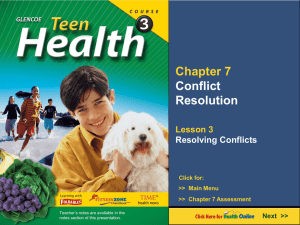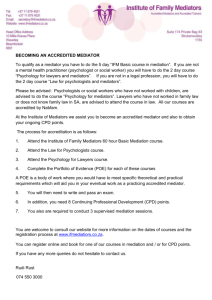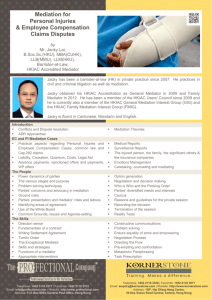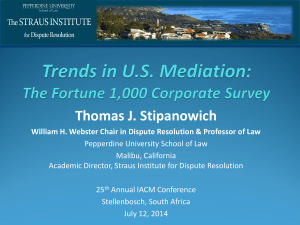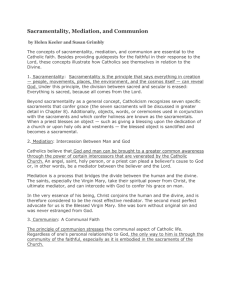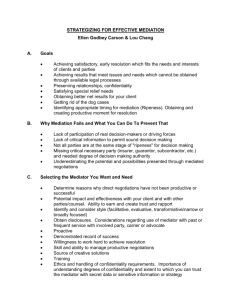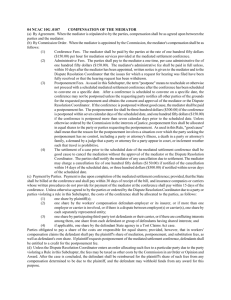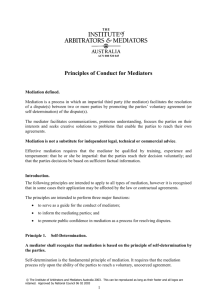4.4 - Gaddis, Mediation
advertisement
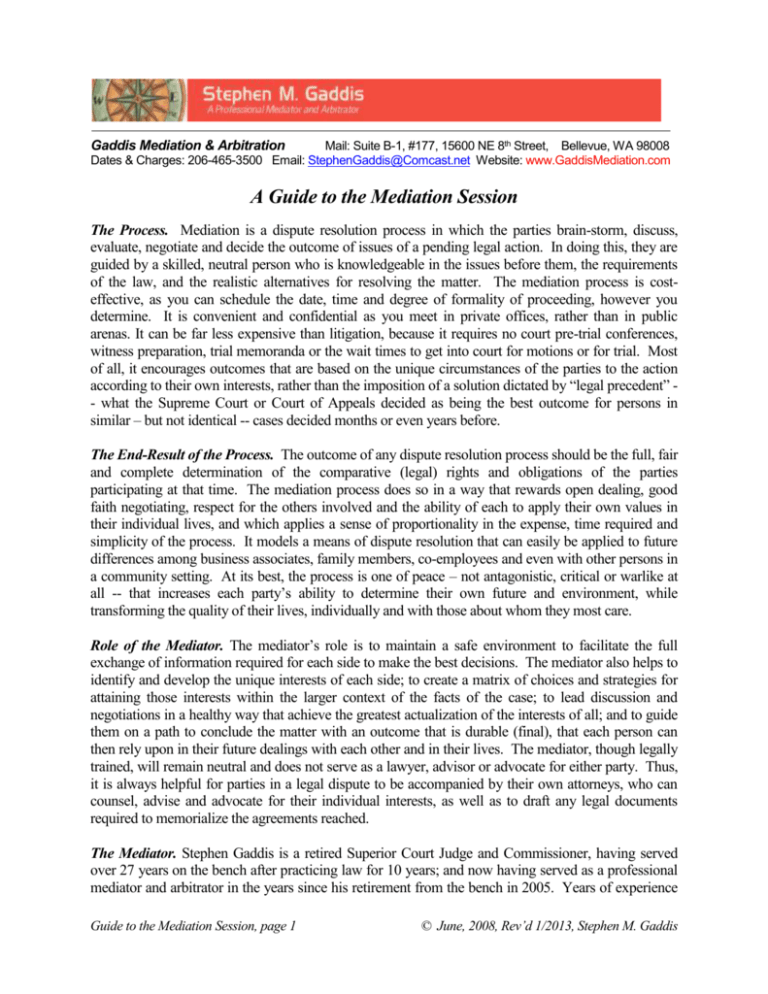
Gaddis Mediation & Arbitration Mail: Suite B-1, #177, 15600 NE 8th Street, Bellevue, WA 98008 Dates & Charges: 206-465-3500 Email: StephenGaddis@Comcast.net Website: www.GaddisMediation.com A Guide to the Mediation Session The Process. Mediation is a dispute resolution process in which the parties brain-storm, discuss, evaluate, negotiate and decide the outcome of issues of a pending legal action. In doing this, they are guided by a skilled, neutral person who is knowledgeable in the issues before them, the requirements of the law, and the realistic alternatives for resolving the matter. The mediation process is costeffective, as you can schedule the date, time and degree of formality of proceeding, however you determine. It is convenient and confidential as you meet in private offices, rather than in public arenas. It can be far less expensive than litigation, because it requires no court pre-trial conferences, witness preparation, trial memoranda or the wait times to get into court for motions or for trial. Most of all, it encourages outcomes that are based on the unique circumstances of the parties to the action according to their own interests, rather than the imposition of a solution dictated by “legal precedent” - what the Supreme Court or Court of Appeals decided as being the best outcome for persons in similar – but not identical -- cases decided months or even years before. The End-Result of the Process. The outcome of any dispute resolution process should be the full, fair and complete determination of the comparative (legal) rights and obligations of the parties participating at that time. The mediation process does so in a way that rewards open dealing, good faith negotiating, respect for the others involved and the ability of each to apply their own values in their individual lives, and which applies a sense of proportionality in the expense, time required and simplicity of the process. It models a means of dispute resolution that can easily be applied to future differences among business associates, family members, co-employees and even with other persons in a community setting. At its best, the process is one of peace – not antagonistic, critical or warlike at all -- that increases each party’s ability to determine their own future and environment, while transforming the quality of their lives, individually and with those about whom they most care. Role of the Mediator. The mediator’s role is to maintain a safe environment to facilitate the full exchange of information required for each side to make the best decisions. The mediator also helps to identify and develop the unique interests of each side; to create a matrix of choices and strategies for attaining those interests within the larger context of the facts of the case; to lead discussion and negotiations in a healthy way that achieve the greatest actualization of the interests of all; and to guide them on a path to conclude the matter with an outcome that is durable (final), that each person can then rely upon in their future dealings with each other and in their lives. The mediator, though legally trained, will remain neutral and does not serve as a lawyer, advisor or advocate for either party. Thus, it is always helpful for parties in a legal dispute to be accompanied by their own attorneys, who can counsel, advise and advocate for their individual interests, as well as to draft any legal documents required to memorialize the agreements reached. The Mediator. Stephen Gaddis is a retired Superior Court Judge and Commissioner, having served over 27 years on the bench after practicing law for 10 years; and now having served as a professional mediator and arbitrator in the years since his retirement from the bench in 2005. Years of experience Guide to the Mediation Session, page 1 © June, 2008, Rev’d 1/2013, Stephen M. Gaddis and of teaching Dispute Resolution to the courts, lawyers and at Seattle University School of Law have taught him that the best solutions to issues coming before the courts come from the parties themselves, rather than being those imposed upon them by an unknowing (however wise or wellintended), third-person judge, who is a stranger to the parties, the issues, the families, their estates, their values, their history and their aspirations. Steps in the Process 1. Orientation to the Process/Ground Rules. The mediator will introduce you to the means, tools and techniques that may be used in the process. The mediator will handle the paperwork and disclosures required by Washington law (the Uniform Mediation Act), and answer your questions about the process. 2. Gathering Information (the Operative Facts). The attorneys and the mediator will identify and gather all the factual information necessary to achieve a full and final settlement of the matters at issue. This is accomplished by the exchange of settlement letters and addenda; the use of various worksheets and checklists; and the creation of drafts of the documents required by the court to effectuate the matter according to the terms agreed upon by the parties. 3. Identification of Issues & Interests. The parties then meet privately with their attorneys and the mediator in separate rooms to identify the specific issues and interests of each of the parties and the best strategies for attaining those. In these conferences, the emphasis is in discussing what is required to move forward toward the goals sought, not in re-hashing the past problems of the incident or relationship or in telling stories about the other party, except as they may directly affect the outcome. 4. Negotiating the Resolution. The parties and their counsel then negotiate a resolution by exchanging written offers thru the mediator, who assists in brain-storming alternatives and outcomes, tempering requests by commonly-expected outcomes, and by answering, discussing and evaluating the various possibilities. Negotiations proceed with offers and counter-offers being exchanged, much like a real estate purchase and sale transaction, effectively becoming a values clarification experience. 5. Drafting the Final (Legal) Papers. While offers are still being exchanged and thereafter, the mediator will encourage and supervise the completion of drafts of the legal documents necessary to memorialize the agreement reached and in order to secure full court approval of the settlement. The Nature of Conflict. Whether a matter is negotiated, mediated, arbitrated or litigated, there will always be challenges. It is natural to want to avoid conflict and confrontation, yet often some degree of this may occur in order for a fair and complete outcome to be achieved. One must look within, as well as without, to identify one’s true needs and interests. This can be difficult, especially while evaluating damages or suffering a loss such as the ending a relationship. By managing this examination and evaluation within the safety of the mediation process rather than in a public courtroom, the values of introspection, dignity, respect, privacy and growth can be affirmed and redirect a person who is a legal party to a new path, healthy and free of some of the constraints that were controlling or affecting one’s life previously. Guide to the Mediation Session, page 2 © June, 2008, Rev’d 1/2013, Stephen M. Gaddis Mediation Outcome. The outcome of the process is a fully binding, written agreement set forth in a document called a Civil Rule 2A Stipulation, which is signed by the parties, their counsel and the mediator. This document, which itself is a FINAL agreement of the issues contained within, makes the settlement effective, even though the legal papers necessary to ratify the matter may need to be prepared later for court approval. “Civil Rule 2A” is the special rule adopted by the Washington State Supreme Court which authorizes the parties to enter into a binding, non-appealable, private settlement of the issues. If time and circumstances allow, the court papers for each of the issues resolved will be drafted by the lawyers, while the other issues are still being negotiated. Occasionally a full settlement may not be reached at the first mediation session, as in some cases the issues are numerous or complex. In those cases, a second session may be scheduled. In other cases the parties may agree to have the mediator arbitrate the remaining issues -- particularly if they are incidental, minor, or merely have to do with the legal drafting. If the matter was close to settling and time ran out, the mediator may leave the parties with an oral or written recommendation for resolution of the remaining issues. Finally, there are occasional cases in which a party may not negotiate in good faith or the parties simply need to have someone else decide what is best for them, in which case the matter will return to the negotiation, full arbitration or the litigation and trial track. Collaborative Law & Cooperative Law. Collaborative Law is one of the more recently developed alternative means for resolving the issues of a legal action. The use of a mediator in such proceedings, either at the early stage wherein a mediator may act as a case manager or at a later stage wherein the parties and counsel near an impasse, is entirely consistent with the values protected in the Collaborative Law process. The mediator will utilize facilitative mediation (self-determination by the parties), protect the fairness of the process (provide a safe container), insist upon a full exchange of information and open dealing (transparency), protect the confidentiality of the parties, and guide them to a solution that is final and enforceable (durable). Cooperative Law is functionally much like and parallel to Collaborative Law. It utilizes the same tenets of dispute resolution and the mediator serves in the same manner as with Collaborative Law, but without the requirement of withdrawal agreement. When to Bring the Mediator on Board. It is never too soon (or too late) to employ the helpful services of a mediator. In “Early Stage Mediation” the mediator can function as a case manager and save the parties and counsel much time (and many dollars) by simplifying and directing the discovery process and later negotiations. In mid-term cases, impasse or stalling can be avoided. And even in “courthouse steps” mediation, the incredible demands of trial, the parties’ loss of control over their own futures and the impoverishment of their estate can be avoided. Conclusion. Kenneth Cloke wrote in Mediating Dangerously, that life is a series of negotiations. Mediation of issues that have become legal matters will likely lead not only to a settlement of those issues presently before them, but will also provide a positive model for successful future negotiations that may involve the same parties, families or relationships in employment or community settings. All the while, you will be spared the great emotional and financial hardship that litigation of those same issues would cause. Parties leaving a mediation setting almost always feel listened to, affirmed and relieved. Persons leaving a courtroom, to the contrary, often feel that they have not been heard or treated fairly; that they “lost” the case or even if they “won” the case, they were not heard, they lost their vision, their assets and perhaps their relationships with family, friends or their support systems. Guide to the Mediation Session, page 3 © June, 2008, Rev’d 1/2013, Stephen M. Gaddis
